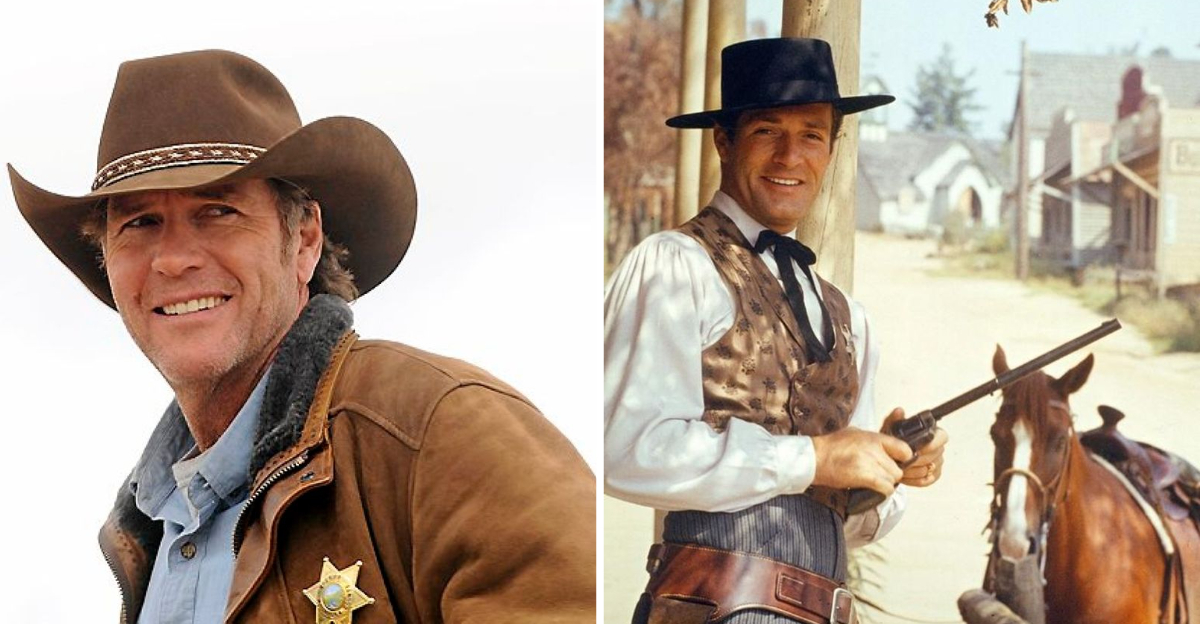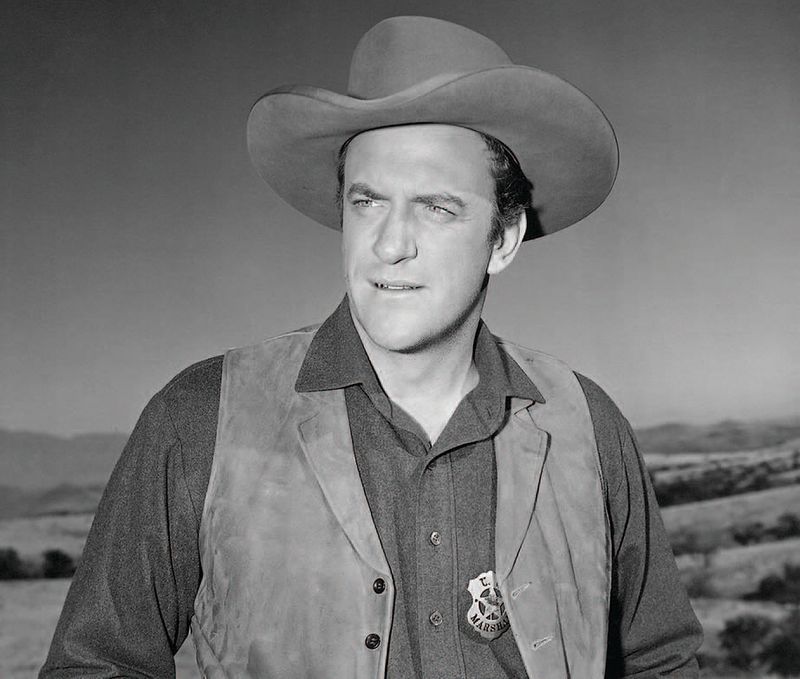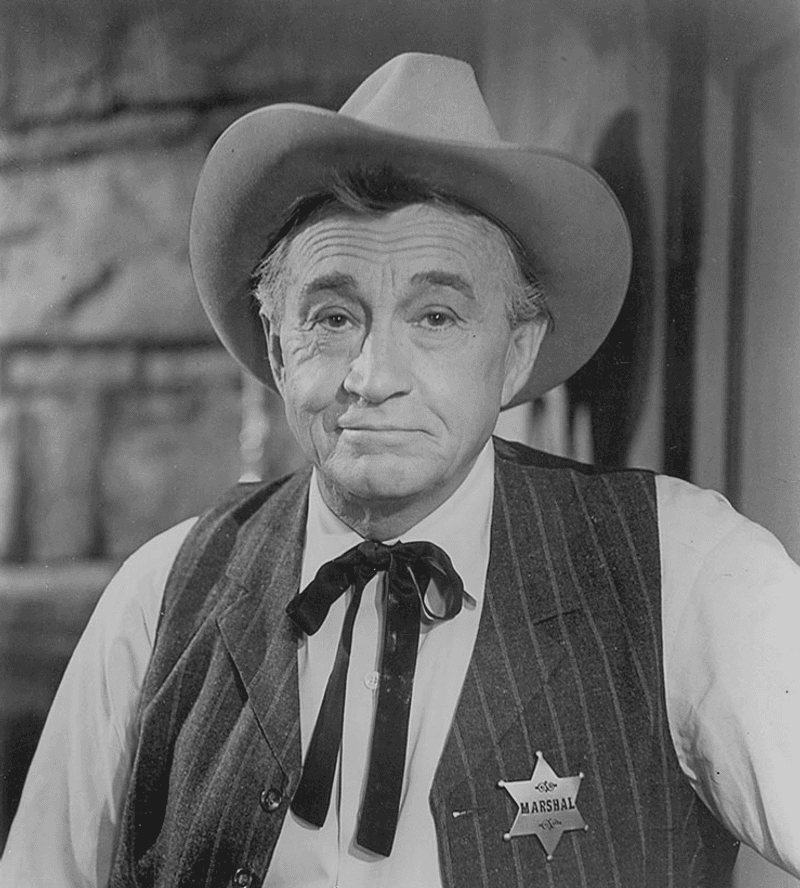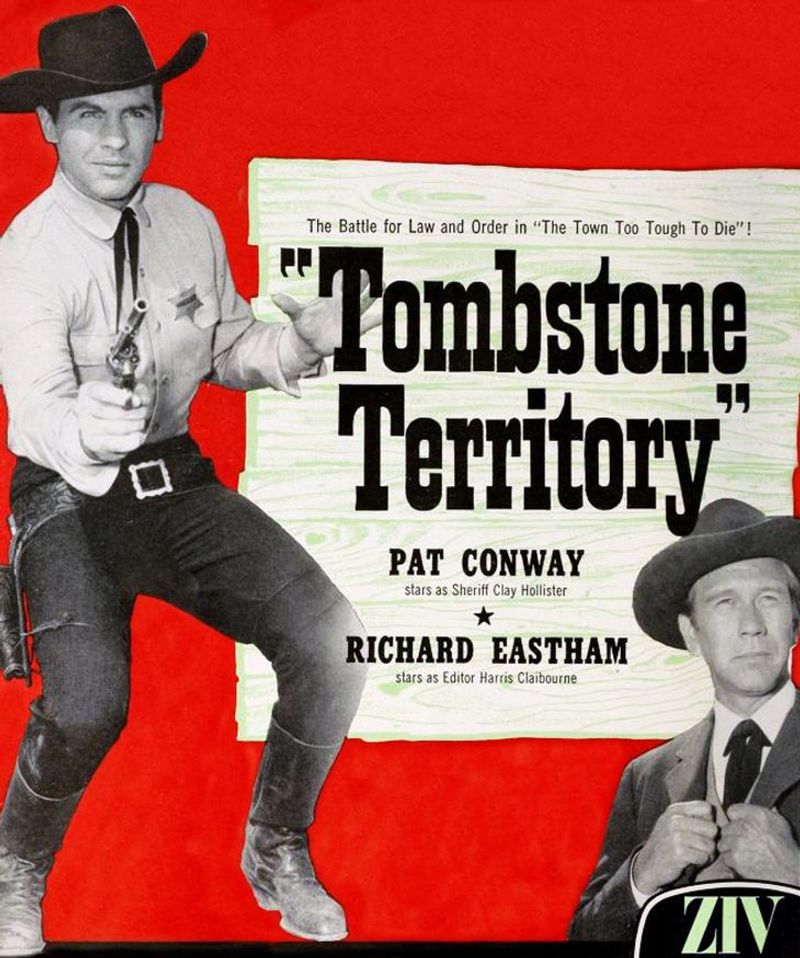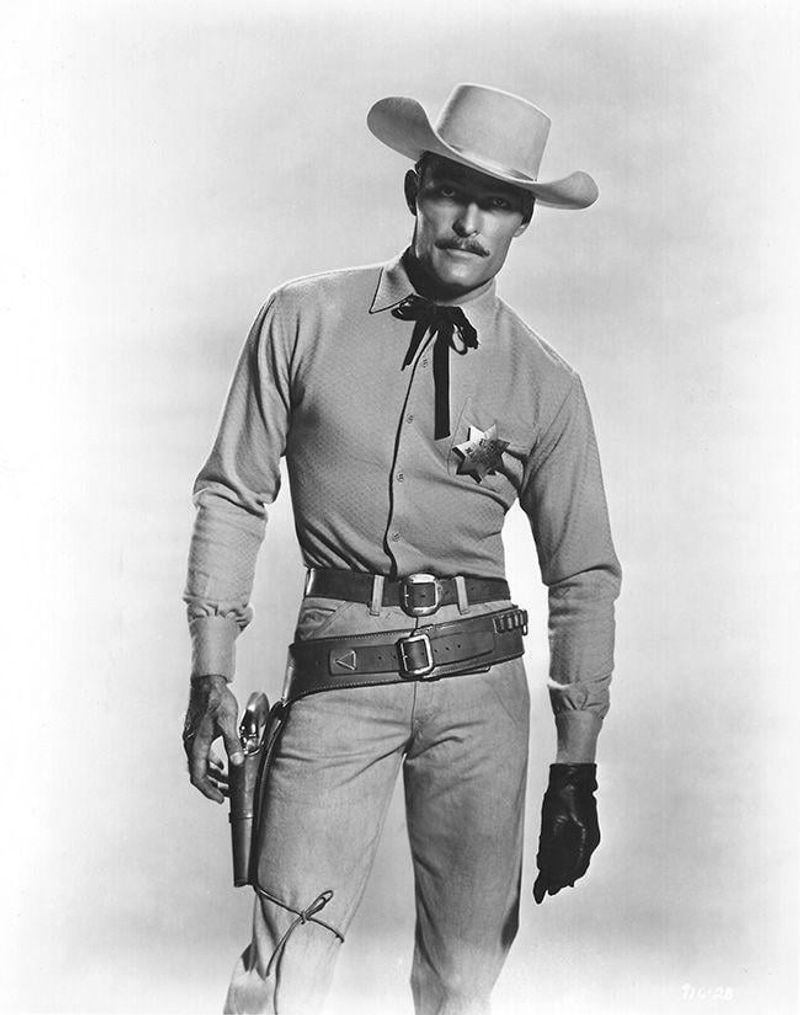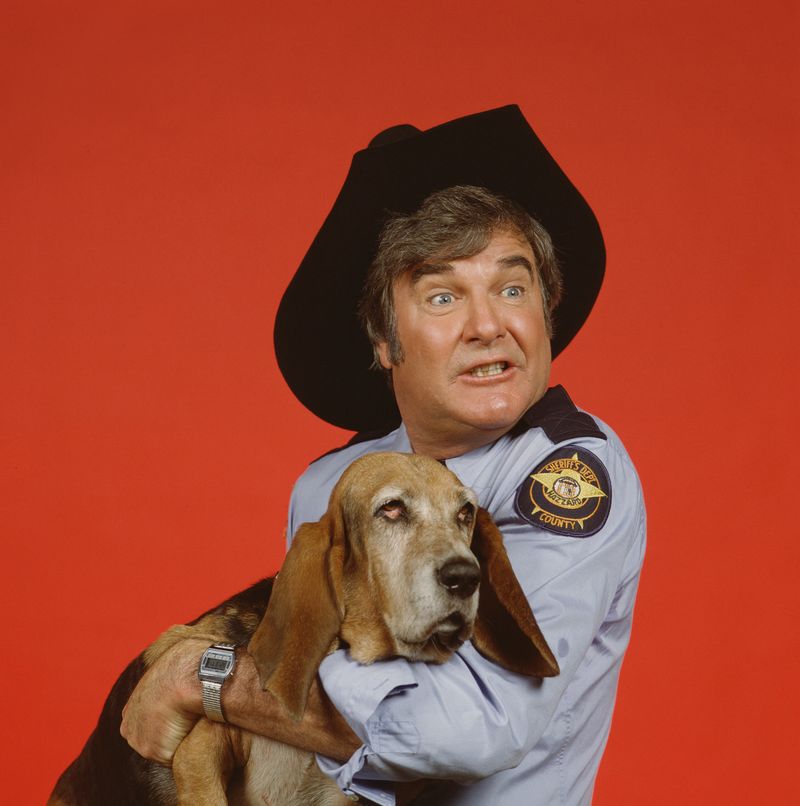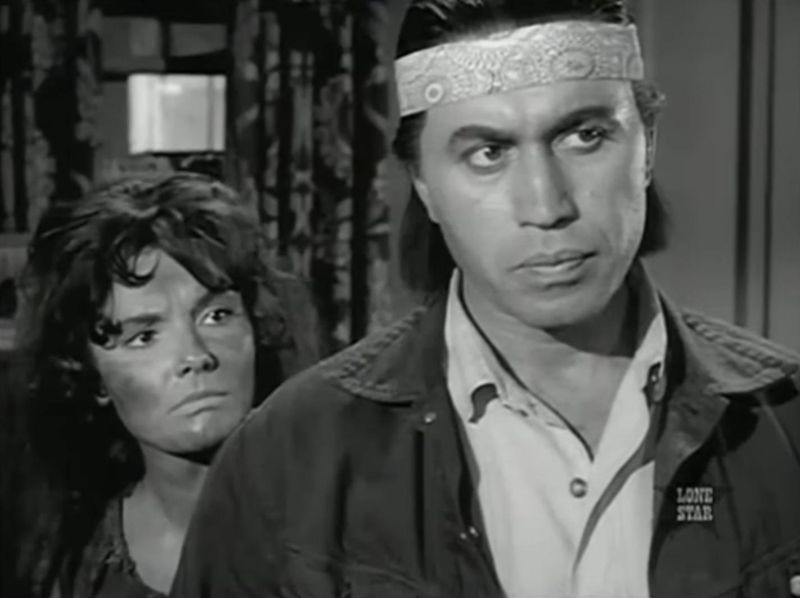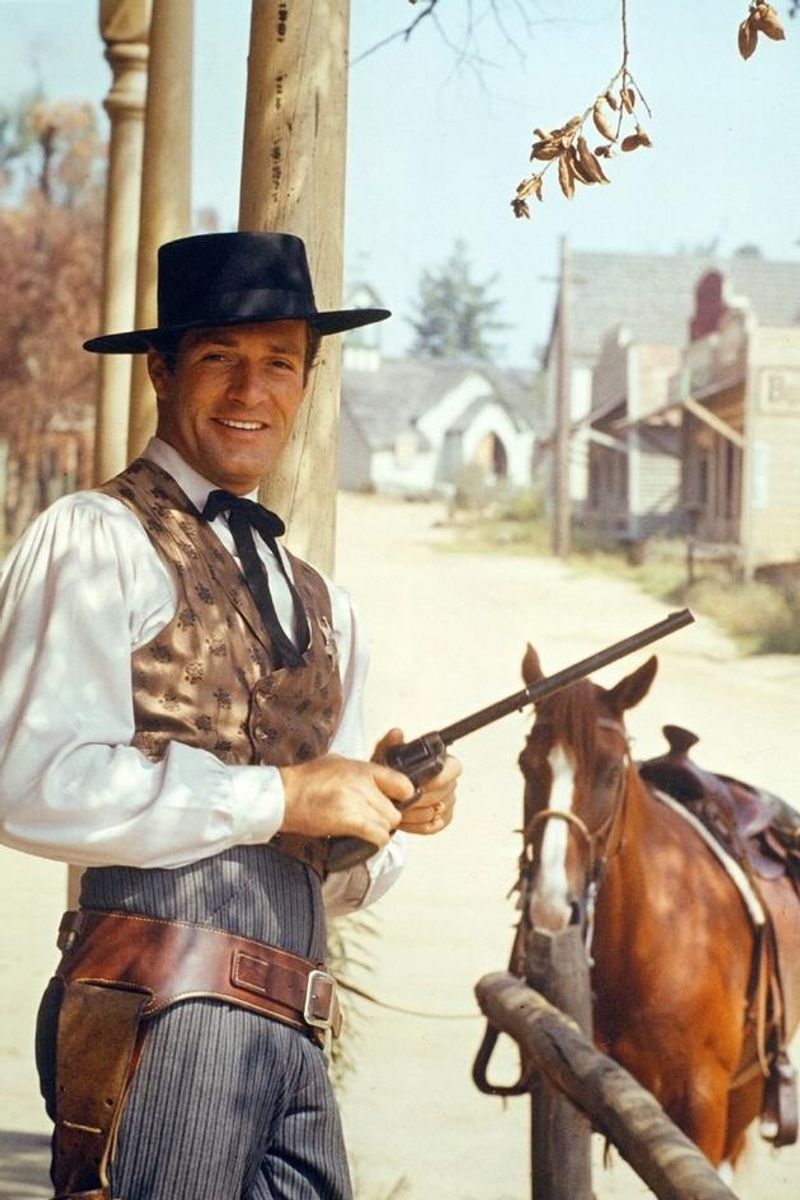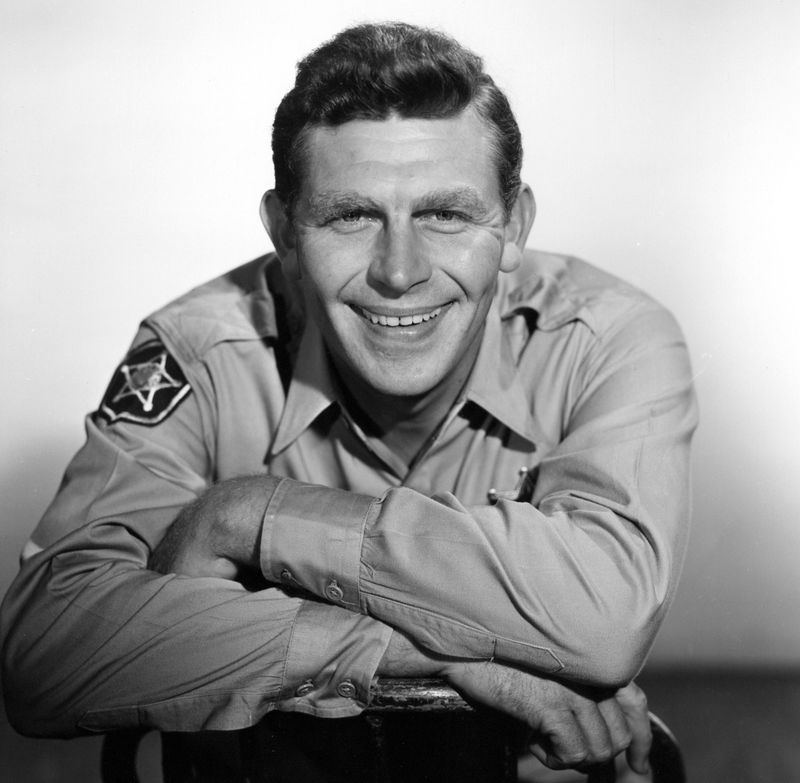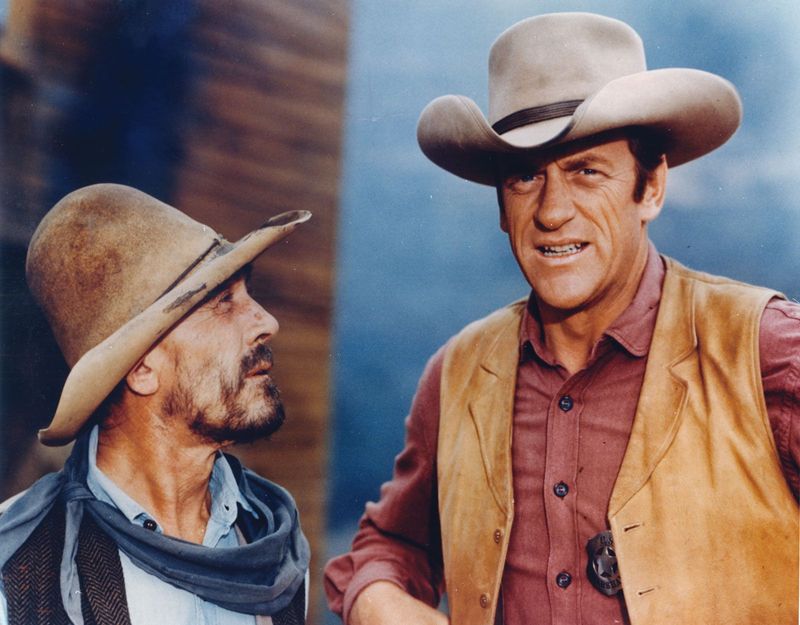The golden age of TV Westerns brought us larger-than-life lawmen who stood for justice, grit, and honor. Whether battling outlaws, taming frontier towns, or upholding the law with a six-shooter, these iconic characters left their mark on television history. From the dusty streets of Dodge City to the rugged terrain of Wyoming, these badge-wearing heroes captured our imaginations and defined an era of television.
1. Marshal Matt Dillon – Gunsmoke
Standing tall at 6’7″, James Arness brought an imposing physical presence to the role that dominated television for 20 remarkable years. Marshal Dillon ruled Dodge City with a perfect balance of strength and compassion. What made Dillon special wasn’t just his quick draw, but his thoughtful approach to justice. He preferred words to bullets when possible, yet never hesitated when action was needed. Gunsmoke’s record-breaking run (1955-1975) gave viewers plenty of time to appreciate Dillon’s unwavering commitment to the law and his community, making him the measuring stick for all TV lawmen who followed.
2. Sheriff Seth Bullock – Deadwood
Timothy Olyphant’s portrayal of the hardware merchant turned reluctant lawman brought raw intensity to HBO’s gritty frontier drama. Unlike the black-and-white morality of earlier westerns, Bullock operated in shades of gray. His rigid moral code constantly battled against Deadwood’s lawless nature and his own violent impulses. The internal struggle made him fascinatingly human. Bullock’s complicated relationship with Al Swearengen created one of television’s most compelling dynamics. His steely gaze and barely contained fury made viewers believe this was a man you didn’t cross, even if he wore a badge rather than an outlaw’s bandana.
3. Marshal Micah Torrance – The Rifleman
Paul Fix brought weathered wisdom to North Fork as the town’s recovering alcoholic lawman. His partnership with rancher Lucas McCain created a perfect balance – Micah’s experience complementing Lucas’s sharpshooting skills. Unlike younger, faster lawmen, Marshal Torrance relied on decades of experience and psychological insight to maintain order. His greatest strength was knowing when to step aside and let McCain handle situations beyond his physical capabilities. The character offered a realistic portrayal of aging in the dangerous frontier. Despite his limitations, Micah’s unwavering dedication to justice made him a beloved figure who proved that lawmen didn’t always need to be the fastest gun.
4. Sheriff Clay Hollister – Tombstone Territory
Pat Conway brought youthful energy to his role as the real-life lawman of Arizona’s most dangerous town. The series stood out for its unique narrative device – using the Tombstone Epitaph newspaper editor as narrator for Hollister’s adventures. Conway’s athletic build and square-jawed good looks made him the perfect television hero, but his portrayal went deeper than mere appearance. His Hollister balanced toughness with surprising compassion. The show’s claim of being based on actual newspaper accounts gave it a documentary feel unusual for the era. Hollister’s adventures highlighted the real dangers faced by frontier lawmen who stood between civilization and chaos in America’s wildest territories.
5. Marshal Dan Troop – Lawman
John Russell’s chiseled features and no-nonsense demeanor perfectly embodied the stern, by-the-book lawman of Laramie, Wyoming. Unlike many western heroes, Troop wasn’t a reluctant lawman – he embraced his role with professional pride. The series focused on Troop’s mentorship of young deputy Johnny McKay, showing the passing of knowledge from one generation of law enforcement to the next. Their father-son dynamic added emotional depth to standard western plots. Russell’s commanding presence made viewers believe he could control a room just by walking into it. Marshal Troop rarely smiled, never backed down, and always upheld his oath – creating a character that embodied the ideal of frontier justice.
6. Sheriff Roscoe P. Coltrane – The Dukes of Hazzard
James Best’s comedic creation might seem out of place among stoic western lawmen, but this bumbling southern sheriff represents television’s evolution of the archetype. His signature “kew-kew-kew” laugh and endless pursuit of “them Duke boys” made him unforgettable. Corrupt and incompetent, yet somehow endearing, Roscoe showed the flip side of frontier justice. His devotion to his basset hound Flash often outweighed his commitment to actual law enforcement. While The Dukes of Hazzard wasn’t technically a western, Roscoe continued the tradition of the rural lawman character. His cartoonish antics and constant defeats provided perfect comic relief while still maintaining the sheriff as a central figure in small-town American storytelling.
7. Deputy Marshal Sam Buckhart – Law of the Plainsman
Michael Ansara broke significant ground as television’s first Native American lawman. As an Oxford-educated Apache working for the U.S. Marshals Service, Buckhart navigated two worlds with dignity and intelligence. The character’s unique background allowed the show to explore prejudice and cultural understanding in ways other westerns couldn’t approach. Buckhart’s calm reasoning often proved more effective than violence. Debuting in 1959 as a spinoff from The Rifleman, the series was revolutionary in presenting a Native American protagonist as heroic, educated, and morally complex. Though short-lived, Buckhart’s character opened doors for more diverse representation in television westerns and left a legacy far beyond its single-season run.
8. Sheriff Johnny Behan – The Life and Legend of Wyatt Earp
Based on the historical figure who clashed with Wyatt Earp, Sheriff Behan represented the complex reality of frontier law enforcement. Various actors portrayed this antagonist who wasn’t simply a villain but a political operator working the system to his advantage. As Tombstone’s county sheriff, Behan’s conflicts with Earp highlighted the territorial disputes and jurisdictional battles that characterized actual western law enforcement. His character showed that wearing a badge didn’t automatically make someone heroic. The historical Behan reportedly collected taxes but failed to pursue outlaws with connections. This morally ambiguous lawman reminds us that frontier justice wasn’t always straightforward – sometimes the line between lawman and outlaw blurred in fascinating ways.
9. U.S. Marshal Jim Crown – Cimarron Strip
Stuart Whitman brought gravitas to this 90-minute western drama that gave its lawman unprecedented challenges. Crown patrolled the massive, lawless Oklahoma Territory with limited resources but unlimited determination. The show’s extended format allowed for more complex storytelling and character development than typical TV westerns. Crown wasn’t just solving weekly problems – he was building civilization in a wilderness. Marshal Crown faced unique challenges in a region where multiple jurisdictions overlapped – tribal lands, territories, and states all created conflicts only a diplomat-lawman could navigate. Despite lasting just one season (1967-1968), the series is remembered for its ambitious scope and Whitman’s nuanced performance as a lawman carrying the weight of an entire territory.
10. Sheriff Andy Taylor – The Andy Griffith Show
Andy Griffith’s gentle sheriff technically falls outside the traditional western genre, yet his character represents the evolution of the American lawman archetype. The widowed father patrolled Mayberry with wisdom instead of weapons, rarely even carrying a gun. Sheriff Taylor solved problems through understanding human nature rather than force. His patient mentoring of Deputy Barney Fife mirrored the teaching relationships in many classic westerns. Though set in contemporary (1960s) North Carolina, the show maintained western themes of community, justice, and moral clarity. Taylor stands as television’s most beloved lawman – proving that the qualities that made western heroes great could translate perfectly to modern settings without losing their essential appeal.
11. Deputy Festus Haggen – Gunsmoke
Ken Curtis transformed from singing cowboy to beloved character actor with his portrayal of the scraggly, unpolished deputy with the distinctive hill-country accent. Festus replaced the beloved Chester Goode (Dennis Weaver) yet managed to win over audiences with his completely different approach. His colorful expressions and folk wisdom provided both comic relief and surprising insights. Behind the rustic exterior beat the heart of a loyal friend who would risk everything for Marshal Dillon. Festus represented the common man turned lawman – lacking formal education but possessing street smarts and frontier skills that proved invaluable. His character showed that effective law enforcement required more than just a fast draw – it needed someone who understood the people and the land.
12. Sheriff Steve Hill – Laramie
Robert Fuller brought youthful energy to his role as the young sheriff of Laramie, Wyoming. Taking over the role in the series’ third season, Fuller’s character added a new dynamic to the show’s established ranch setting. Hill’s backstory included tragedy – his parents were killed by outlaws – giving emotional depth to his commitment to justice. His youth sometimes made townspeople question his authority, creating compelling dramatic tension. Fuller’s athletic build and horseback riding skills made the action sequences particularly convincing. Sheriff Hill represented the next generation of western lawmen – still tied to tradition but bringing fresh energy and perspective to the badge, much like the changing television landscape of the early 1960s.
13. Marshal Frank Morgan – The Big Valley
Charles Bickford made recurring appearances as this grizzled federal marshal who brought old-school frontier justice to the world of the wealthy Barkley family. His no-nonsense approach often clashed with the more progressive views of matriarch Victoria Barkley. Morgan represented the fading era of frontier law enforcement – experienced, uncompromising, and sometimes brutal in his methods. His character created tension by forcing the main characters to confront the changing nature of justice in the developing West. Though not a series regular, Morgan’s appearances always signaled significant episodes dealing with deeper moral questions. Bickford’s commanding presence and gravelly voice made Marshal Morgan memorable despite limited screen time, proving that quality, not quantity, determines a character’s impact.
14. Sheriff Walt Longmire – Longmire
Robert Taylor brought the modern western lawman to life in this contemporary drama set in fictional Absaroka County, Wyoming. Grieving his wife’s death, Longmire embodied the stoic western hero transplanted to present day – solving crimes with minimal technology and maximum intuition. The character bridged western traditions with modern police procedural elements. His complicated relationships with the local Cheyenne reservation addressed contemporary issues while maintaining classic western themes. Longmire proved that the essence of the western lawman remains relevant – a person of integrity standing against chaos, regardless of era. His character demonstrated that even with cell phones and DNA evidence, the fundamental qualities that made western lawmen compelling – courage, wisdom, and moral clarity – remain essential.
15. U.S. Marshal Wyatt Earp – The Life and Legend of Wyatt Earp
Hugh O’Brian’s portrayal of the legendary lawman helped establish the template for television western heroes. Running from 1955 to 1961, the series tracked Earp’s evolution from local police officer to famous frontier marshal. O’Brian’s Earp was noticeably more sophisticated than many western lawmen – well-dressed, articulate, and strategic. His black suit and calm demeanor set him apart from both outlaws and other lawmen. The show blended historical events with Hollywood imagination, creating an idealized version of Earp that influenced public perception more than historical accounts. The famous Tombstone gunfight (inaccurately called the “Gunfight at the O.K. Corral”) became television’s most iconic showdown, cementing Earp’s place as the quintessential western lawman in American popular culture.
